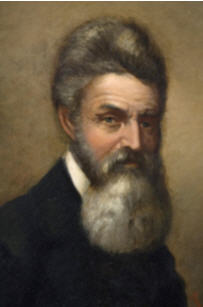
Why John Brown Matters
There is a very special thread that runs through American history. It is the thread of people fighting for freedom and equality for everyone, regardless of race, gender, religion or sexual orientation. It started with a group of radicals in Philadelphia who inspired Tom Paine to write Common Sense in 1776. It is embodied in the lives of many individuals who we have never heard of but, who struggle daily in their communities for these ideals. Every once in a while there emerges a giant whose words and actions so inspire the people around them that they change the world. They are always controversial. They inspire great love among the oppressed and great fear and hate among the status quo. In the middle of the nineteenth century that person was John Brown.
Many people in the nineteenth century who were against slavery, also believed that the freed slaves should leave the United States for Africa or the Caribbean. Not John Brown. He believed that the Golden Rule applied to all people and that the founding document of the United States was the Declaration of Independence, which was also meant for everyone. Brown believed that slavery was such an evil that it should be ended by any means necessary. He believed that all people should be free and treated equally and with respect. Brown addressed all individuals as Mister or Miss, regardless of their race or position. He also believed that there was a point when one needed to stop talking and start taking action.
In 1851, Brown organized the League of Gilead in Springfield, Massachusetts, an armed group pledged to free any person caught by slave catchers. This group was formed in response to Congress' passage of the Fugitive Slave Act, which gave slave owners the use of federal law enforcement powers to go into the North to seek the return of escaped slaves. However, these agents not only captured escaped slaves, but any black person who could not prove they were free.
Beyond the League of Gilead, John Brown was also active in the Underground Railroad helping escaped slaves to reach Canada. He was friends with prominent black abolitionists such as Frederick Douglass and Harriet Tubman, and also many notable Philadelphia abolitionists. In the late 1850s, he took up arms to defend Kansas as a "free state" against pro-slavery forces.
As his anti-slavery commitments continued to deepen, Brown presented his plan for a provisional constitution and guerilla war against slavery to the 1858 convention in Chatham, Canada. This convention was unlike any other: organized by a white man, attended largely by blacks, and designed to raise a black army to trigger an African American revolution that would wipe out slavery. It was here that plans for the attack on the federal arsenal at Harpers Ferry were begun.
The actual Harpers Ferry attack took place on October 16, 1859. As a result, Brown was captured, tried by the State of Virginia, and hung on December 2, 1859. On this very day, Philadelphia abolitionists and the black community honored Brown by declaring "Martyr Day." Black homes and businesses across the city were draped in black and two vigils were held in his honor.
This time around, we'll be remembering the 150th anniversary of the Harpers Ferry Raid and John Brown's death with a full week of music, lectures, theater, exhibits, and history reenactments taking place in locations throughout Philadelphia. We hope you will join us.
FOR MORE INFORMATION, visit www.moonstoneartscenter.org/johnbrown
 David Bustill Bowser, John Brown, oil, 1860 During his travels, John Brown visited the Bowser house in Philadelphia, a stop on the Underground Railroad. This painting is in the collection of the Atwater Kent Museum of Philadelphia and is on exhibit at The National Archives as part of this celebration of John Brown.
David Bustill Bowser, John Brown, oil, 1860 During his travels, John Brown visited the Bowser house in Philadelphia, a stop on the Underground Railroad. This painting is in the collection of the Atwater Kent Museum of Philadelphia and is on exhibit at The National Archives as part of this celebration of John Brown.